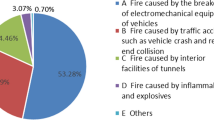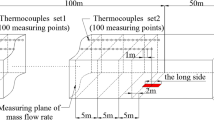Abstract
Underground utility tunnels with various municipal pipelines inside provide convenience for cities and contribute to their sustainable development, but also bring potential fire risks. Previously, the relevant studies have predominately focused on horizontal section, while ignoring the influence of slope at the intersection of utility tunnels. In the present study, the smoke movement and temperature distribution were investigated in utility tunnel fires with five slopes and six heat release rates by numerical simulation. Four different sizes of pool fire experiments were also conducted in a full-scale utility tunnel. The results indicated that: (1) Smoke movement can be divided into five stages, including free rise, diffusion under inclined ceiling, diffusion under horizontal ceiling, flow back, and steady circulation. (2) Temperature upstream is larger than that downstream of the fire source, which is asymmetrically distributed and shows different characteristics with the change in slope. (3) Downstream ceiling temperature decreases gradually with increasing distance from the fire source. An empirical formula is proposed to predict the downstream maximum ceiling temperature rise considering the slope and dimensionless heat release rate. Good agreement was obtained between predicted and experimental values.





















Similar content being viewed by others
Abbreviations
- \(a\) :
-
Coefficient in Eq. (15)
- \({A}_{\mathrm{f}}\) :
-
Combustion area (m2)
- \(b\) :
-
Coefficient in Eq. (15)
- \({c}_{\mathrm{p}}\) :
-
Air heat capacity (kJ kg−1 K−1)
- \(D\) :
-
Diameter of the equivalent circle (m)
- \({D}_{\text i}\) :
-
Diffusion coefficient of the \(i\)th ingredient
- \({D}^{*}\) :
-
Feature diameter of fire source (m)
- \({\varvec{f}}\) :
-
Volume force vector
- \({F}_{\mathrm{r}}\) :
-
Froude number
- \(g\) :
-
Gravitational acceleration (m s−2)
- \({H}_{\mathrm{d}}\) :
-
Distance from fire source to the utility tunnel ceiling (m)
- h :
-
Height of the inclined section (m)
- \(h{\prime}\) :
-
Specific enthalpy, kJ kg−1
- \(k\) :
-
Empirically calculated to be 1.1 (m−1)
- \(K\) :
-
Coefficient in Eq. (9)
- \(\dot{{m}^{{\prime}{\prime}}}\) :
-
Combustion rate (kg m−2 s−1)
- \(\dot{{m}_{\infty }^{{\prime}{\prime}}}\) :
-
Empirical combustion rate (kg m−2 s−1)
- \(R\) :
-
Correlation coefficient
- \(p\) :
-
Pressure (Pa)
- \(q\) :
-
Thermal radiation flux (kW m−2)
- \(Q\) :
-
Heat release rate of fire source (Kw)
- \({Q}^{\star }\) :
-
Dimensionless fire heat release rate
- \(t\) :
-
Time (s)
- \({T}_{\mathrm{a}}\) :
-
Ambient temperature (K)
- \(\Delta {H}_{\mathrm{c}}\) :
-
Complete heat of combustion (MJ kg−1)
- \(\Delta {T}_{\mathrm{max}}\) :
-
Maximum excess ceiling temperature (K)
- \(u\) :
-
Longitudinal ventilation velocity (m s−1)
- \({\varvec{u}}\) :
-
Velocity vector
- \(x\) :
-
Horizontal distance from the fire source (m)
- \({Y}_{\text i}\) :
-
Mass fraction of the \(i\)th ingredient
- \(\alpha\) :
-
Slope of the inclined section (%)
- \(\beta\) :
-
Coefficient in Eq. (4)
- γ:
-
Coefficient in Eq. (12)
- \(\varepsilon\) :
-
Coefficient in Eq. (4)
- \(\theta\) :
-
Slope of the tunnel (%)
- \(\delta\) :
-
Grid size (m)
- \(\rho\) :
-
Density, kg m−3
- \({\rho }_{\mathrm{a}}\) :
-
Air density (kg m−3)
- \({\varvec{\tau}}\) :
-
Viscous tension per unit area
- \({\varvec{\psi}}:\) :
-
Coefficient in Eq (14)
- \(\chi\) :
-
Combustion efficiency
- \(\Phi\) :
-
Dissipation rate (kW m−3)
References
Ye K, Zhou X, Zheng Y, et al. Estimating the longitudinal maximum gas temperature attenuation of ceiling jet flows generated by strong fire plumes in an urban utility tunnel. Int J Therm Sci. 2019;142:434–48. https://doi.org/10.1016/j.ijthermalsci.2019.04.023.
Cano-Hurtado JJ, Canto-Perello J. Sustainable development of urban underground space for utilities. Tunn Undergr Space Technol. 1999;14(3):335–40. https://doi.org/10.1016/S0886-7798(99)00048-6.
Canto-Perello J, Curiel-Esparza J. An analysis of utility tunnel viability in urban areas. Civ Eng Environ Syst. 2006;23(1):11–9. https://doi.org/10.1080/10286600600562129.
Wang T, Tan L, Xie S, et al. Development and applications of common utility tunnels in China. Tunn Undergr Space Technol. 2018;76:92–106. https://doi.org/10.1016/j.tust.2018.03.006.
Wu J, Bai Y, Fang W, et al. An integrated quantitative risk assessment method for urban underground utility tunnels. Reliab Eng Syst Saf. 2021;213:107792. https://doi.org/10.1016/j.ress.2021.107792.
Bai Y, Zhou R, Wu J. Hazard identification and analysis of urban utility tunnels in China. Tunn Undergr Space Technol. 2020;106:103584. https://doi.org/10.1016/j.tust.2020.103584.
Piccinini N, Tommasini R, Pons E, Large NG. explosion and fire involving several buried utility networks. Process Saf Environ Protect. 2009;87(2):73–80. https://doi.org/10.1016/j.psep.2008.02.007.
Wang P, Zhu G, Pan R, et al. Effects of curved sidewall on maximum temperature and longitudinal temperature distribution induced by linear fire source in utility tunnel. Case Stud Therm Eng. 2020;17:100555. https://doi.org/10.1016/j.csite.2019.100555.
Liang K, Hao X, An W, et al. Study on cable fire spread and smoke temperature distribution in T-shaped utility tunnel. Case Stud Therm Eng. 2019;14:100433. https://doi.org/10.1016/j.csite.2019.100433.
An W, Tang Y, Liang K, et al. Study on temperature distribution and CO diffusion induced by cable fire in L-shaped utility tunnel. Sust Cities Soc. 2020;62:102407. https://doi.org/10.1016/j.scs.2020.102407.
Mi H, Liu Y, Jiao Z, et al. A numerical study on the optimization of ventilation mode during emergency of cable fire in utility tunnel. Tunn Undergr Space Technol. 2020;100:103403. https://doi.org/10.1016/j.tust.2020.103403.
Pan R, Zhu G, Liang Z, et al. Experimental study on the fire shape and maximum temperature beneath ceiling centerline in utility tunnel under the effect of curved sidewall. Tunn Undergr Space Technol. 2020;99:103304. https://doi.org/10.1016/j.tust.2020.103304.
Ye K, Tang X, Zheng Y, et al. Estimating the two-dimensional thermal environment generated by strong fire plumes in an urban utility tunnel, Process Saf. Environ Protect. 2021;148:737–50. https://doi.org/10.1016/j.psep.2021.01.030.
Gao Z, Li L, Zhong W, et al. Characterization and prediction of ceiling temperature propagation of thermal plume in confined environment of common services tunnel. Tunn Undergr Space Technol. 2021;110:103714. https://doi.org/10.1016/j.tust.2020.103714.
Huang P, Ye S, Qin L, et al. Experimental study on the maximum excess ceiling gas temperature generated by horizontal cable tray fires in urban utility tunnels. Int J Therm Sci. 2022;172:107341. https://doi.org/10.1016/j.ijthermalsci.2021.107341.
Ji J, Wan H, Li K, et al. A numerical study on upstream maximum temperature in inclined urban road tunnel fires. Int J Heat Mass Tran. 2015;88:516–26. https://doi.org/10.1016/j.ijheatmasstransfer.2015.05.002.
Smagorinsky J. General circulation experiments with the primitive equations. Mon Weather Rev. 1963;91(3):99–164.
Fan CG, Li XY, Mu Y, et al. Smoke movement characteristics under stack effect in a mine laneway fire. Appl Therm Eng. 2017;110:70–9. https://doi.org/10.1016/j.applthermaleng.2016.08.120.
Gao Z, Li L, Sun C, et al. Effect of longitudinal slope on the smoke propagation and ceiling temperature characterization in sloping tunnel fires under natural ventilation. Tunn Undergr Space Technol. 2022;123:104396. https://doi.org/10.1016/j.tust.2022.104396.
Han J, Liu F, Wang F, et al. Study on the smoke movement and downstream temperature distribution in a sloping tunnel with one closed portal. Int J Therm Sci. 2020;149:106165. https://doi.org/10.1016/j.ijthermalsci.2019.106165.
Mcgrattan KB, Mcdermott RJ, Weinschenk C G, et al. Fire Dynamics Simulator User's Guide, Nist Special Publication; 2013.
Karlsson B, Quintiere J G. Enclosure fire dynamics, CRC Press; 2000.
Król M, Król A, Koper P, et al. The influence of natural draught on the air flow in a tunnel with longitudinal ventilation. Tunn Undergr Space Technol. 2019;85:140–8. https://doi.org/10.1016/j.tust.2018.12.008.
Wang Z, Ding L, Wan H, et al. Numerical investigation on the effect of tunnel width and slope on ceiling gas temperature in inclined tunnels. Int J Therm Sci. 2020;152:106272. https://doi.org/10.1016/j.ijthermalsci.2020.106272.
Oka Y, Imazeki O. Temperature and velocity distributions of a ceiling jet along an inclined ceiling – Part 1: approximation with exponential function. Fire Saf J. 2014;65:41–52. https://doi.org/10.1016/j.firesaf.2013.07.009.
Oka Y, Oka H, Imazeki O. Ceiling-jet thickness and vertical distribution along flat-ceilinged horizontal tunnel with natural ventilation. Tunn Undergr Space Technol. 2016;53:68–77. https://doi.org/10.1016/j.tust.2015.12.019.
Kurioka H, Oka Y, Satoh H, et al. Fire properties in near field of square fire source with longitudinal ventilation in tunnels. Fire Saf J. 2003;38(4):319–40. https://doi.org/10.1016/S0379-7112(02)00089-9.
Li YZ, Lei B, Ingason H. The maximum temperature of buoyancy-driven smoke flow beneath the ceiling in tunnel fires. Fire Saf J. 2011;46(4):204–10. https://doi.org/10.1016/j.firesaf.2011.02.002.
Hu LH, Chen LF, Wu L, et al. An experimental investigation and correlation on buoyant gas temperature below ceiling in a slopping tunnel fire. Appl Therm Eng. 2013;51(1):246–54. https://doi.org/10.1016/j.applthermaleng.2012.07.043.
Acknowledgements
This work was supported by the National Natural Science Foundation of China (no. 52076202), Anhui Provincial Key R&D Program (no. 2022m07020013) and Anhui Provincial Natural Science Foundation (no. 2008085ME153).
Author information
Authors and Affiliations
Contributions
KW contributed to the experiment, simulation, data curation, and writing—original draft preparation. ZL and DW carried out review of experimental and simulation results and helped in editing the drafts leading to the final version. XZ was involved in the data curation and writing—original draft preparation. LY and XJ assisted in the conceptualization, methodology, writing—original draft preparation, reviewing and editing, and supervision. All authors read and approved the final manuscript.
Corresponding authors
Additional information
Publisher's Note
Springer Nature remains neutral with regard to jurisdictional claims in published maps and institutional affiliations.
Rights and permissions
Springer Nature or its licensor (e.g. a society or other partner) holds exclusive rights to this article under a publishing agreement with the author(s) or other rightsholder(s); author self-archiving of the accepted manuscript version of this article is solely governed by the terms of such publishing agreement and applicable law.
About this article
Cite this article
Wang, K., Lu, Z., Wang, D. et al. Effect of slope on smoke movement and temperature profile in underground utility tunnel. J Therm Anal Calorim 148, 10285–10300 (2023). https://doi.org/10.1007/s10973-023-12411-x
Received:
Accepted:
Published:
Issue Date:
DOI: https://doi.org/10.1007/s10973-023-12411-x




